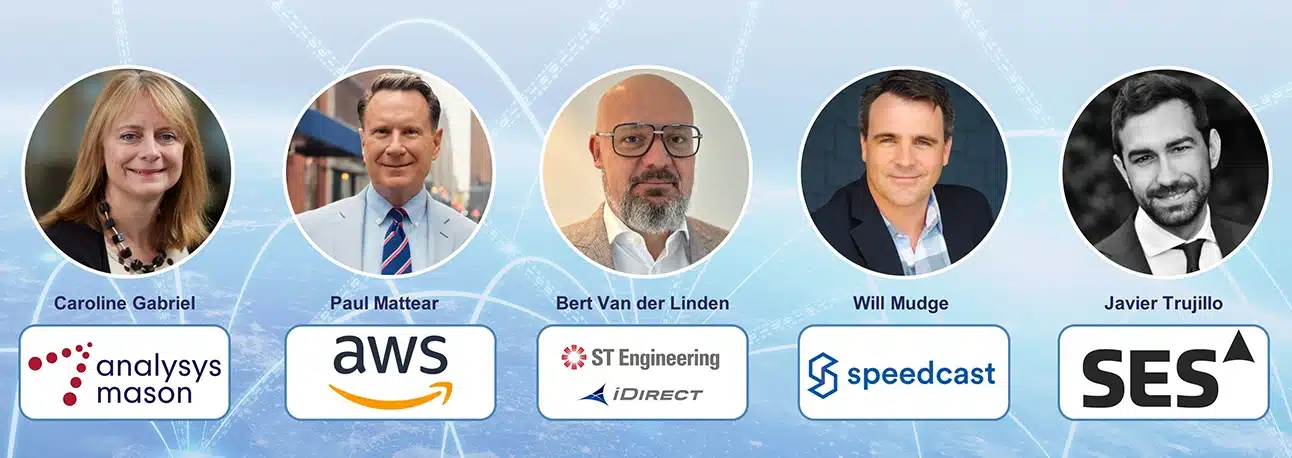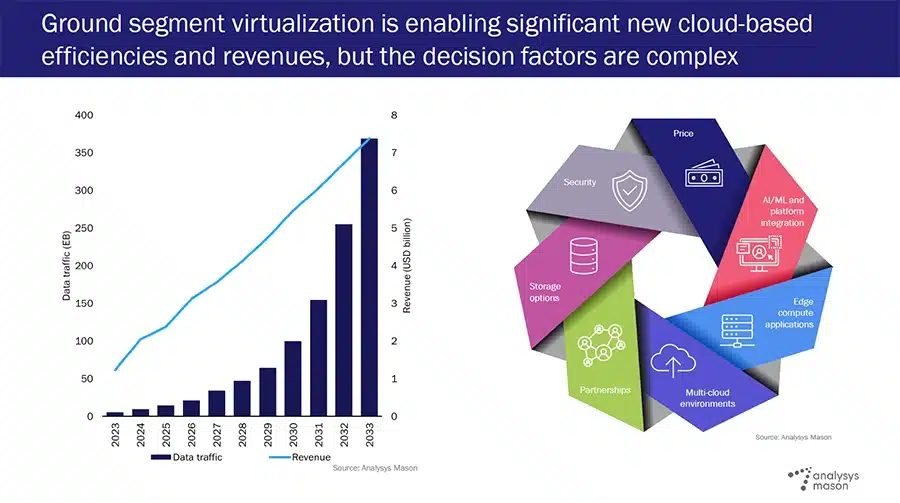Some key questions were put to an industry-leading panel on the adoption of cloud technologies by the satcom industry last week during the Global Satellite Operator’s Association (GSOA’s) webinar, Cloud Bound: A Gateway to Unparalleled Flexibility and Reliability.
The line-up featured different players in the ecosystem: Paul Mattear, Head of Global Satellite Communications, Amazon Web Services, Will Mudge, Senior Vice President of Technology and Operations at Speedcast, Javier Trujillo, Digital Ground Development Senior Manager at SES and our very own Bert Van den Linden, Senior Principal Product Manager, Hub Solutions.
The panel, under the moderation of Caroline Gabriel, Research Director at Analysys Mason explored the burning topics around cloud migration, if you couldn’t attend the session, we provided the key takeaways below …so keep on reading!
The Drivers
First, Caroline provided her view of the factors that must be considered for enterprises moving to the cloud.
When asking the panelists about the top drivers for a move to the cloud, flexibility, scale and reduction of time to market (and therefore time to revenue), were the top considerations. Cloud equals efficiencies, lower costs and the means to innovate faster.
Outside of this, Paul also pointed out that at AWS, data sovereignty is also something that is increasingly important to customers. “They want to keep their data within their physical geographical boundaries,” he explained. To meet this need, AWS have added countries to their portfolio.
For SES, it was enabling responsiveness: “…it’s the commercial agility that we will be able to reach with the solution. And then in second place, I would position the efficiency and cost,” Javier said. The convenience of being able to locate infrastructure where it is required at different times of the year for cruise traffic, for example, helps to reduce TCO.
The Benefits and Opportunities – A new means of service delivery
The cloud offers a plethora of benefits to companies that migrate to it though it’s a gradual journey to achieve full migration. The panel agreed that for any business, it was a solid approach to begin with one main challenge that can be solved through adoption of the cloud and move from there.
The cloud offers new means of service delivery, new paths to monetization, the ability to respond quickly to technology advancements and new applications, and lower TCO. Paul noted that in a recent whitepaper released by IDC, it was found that the cloud results in a huge 51% reduction in operational costs.
Will Mudge remarked that the cloud has been a definite benefit from the perspective of availability in remote regions. “From a remote site communications perspective, as you can imagine, our customers are very spread out. We’re literally on every continent. So, being able to not have physical servers in a particular area means we can leverage somebody like AWS’s servers in a region or in availability clusters and it really helps us to improve the customer experience. You’re not in Australia having to use a server that’s sitting back in Scotland on the other side of the world.”
Certain use cases, such as occasional events, benefit from the deployment of network processing functions in the cloud region, providing customers with immediate global reach or datacenter capacity along with their cloud service provider of choice.
Javier Trujillo highlighted the importance of the ground segment that acts as the glue that holds it all together. “All of these services could not be provided without a global ground infrastructure. That is what allows us to control and feed these satellites so that we can then connect our customers to wherever they need,” he said.
Challenges
From the cloud service provider (CSP) perspective, Paul explained that one of the biggest challenges AWS faces is the ability to support their customers’ growth: “…one of the largest challenges that we see out there, as a global cloud operator, is really making sure that we’re able to support our customers as they scale. And that means opening more and more regions globally…Our biggest challenge is making sure that we continue to grow with our customers at the rate that we’re seeing.”
TCO was also a principal consideration as Javier explained: “The biggest one [challenge] to me is the question that we have around the total cost of ownership. It’s good we have here the interested parties and I think we will need to get into further discussions to better understand exactly how the cloud providers, vendor providers, satellite network operators, can all work together to create a safe ecosystem profitable for all of us.”
The digitalization and cloudification of satellite networks also necessitate the requirement to meet minimum hardware standards. However, rather than a barrier to progress, at ST Engineering iDirect, we would see standards-based implementation as more of an opportunity to update the customer platforms and ensure that the extensive benefits of virtualization can be accessed and maintained in the long-term.
It will also mean the move from a CAPEX to an OPEX business model, where the focus is not on the purchase of hardware to enable a service, but on operational expenditure to ensure that software is regularly updated, enabling the service to run smoothly and eliminating the need for physical upgrades to hardware.
All four panelists agreed that a critical barrier, however, is a lack of standards, which has led to challenges with interoperability.
Standards
We know that the satellite industry has a long way to travel to catch up with the telecom sector which embraced roaming due to the adoption of standards many years ago.
Paul added that standardization is key. He said: “I personally think that the lack of standards is still killing us in the satellite world. That lack of standards is really holding us back from where we should be at this time, able to go from one constellation to the other. That, I think, would really enhance satcom as a whole and provide us a measure of growth.”
Javier backed up Paul’s view on the importance of standards. “I think it’s key,” he said. I know we are already working towards that, but I think we need more of that to make sure that this is a feasible system and solution.”
At ST Engineering iDirect, standards for digitization and virtualization are of paramount importance. “We are committed to standards-based innovation and industry collaboration that will lead to the goal of interoperability,” said Bert. “We also need to bear in mind that this is something that won’t be accomplished overnight and demands cooperation from the ecosystem.”
That’s why we’ve been working with other industry players on standards through membership of the DIFI (Digital Intermediate Frequency Interoperability) consortium that works to provide a simple, open, interoperable digital IF/RF standard based on the VITA 49 radio transport standard, that replaces the natural interoperability of analog IF signals and helps prevent vendor lock-in. The DIFI standard facilitates Virtual Network Functions (VNFs), transforming satcom modems and network processing from hardware appliances into cloud-based software.
iDirect has long spearheaded the development of standards, from OpenAMIP and Open BMIP to DIFI and most recently with the formation of the WAVE Consortium where we sit on the Board alongside AWS and SES and define specifications and documentation for COTS infrastructure for our industry. We’ve also participated in the recent DIFI Plugfest and have showcased the exchange of DIFI streams between ourselves and other vendors.
Not the flick of a switch
A pivotal point made during the webinar came from Paul, who explained that the move to the cloud does not bring instant efficiencies. It is a process. The fact that customers already have physical hardware makes the move to the cloud more difficult. This migration won’t happen at the flick of a switch, and this must be appreciated by all involved in the cloud ecosystem so that steps are taken to enable a gradual migration as and when a customer is ready.
He explained: “[Your company] just can’t drop its infrastructure. Although we do see 62% increase in productivity within it when they move to the cloud. These efficiencies aren’t immediate. This is something I want to get clear. For those who are looking starting their cloud journey. These efficiencies don’t happen overnight.”
A company with its own datacenter could potentially move half of its operations to the cloud but the high efficiencies will not be evident straight away. Power will still be switched on, staff will still be manning it, so as a company, you are still paying for that physical infrastructure.
Will made the point that we need to find a way to move some operations from on prem to the cloud, but that this will be a balancing act. “There are benefits of both, from a timing perspective and the likes. But no matter what, we’re going to have to adopt to new standards.” Will went on to explain that this change is being forced upon the industry by the likes of Starlink and OneWeb. Their operations are already in the cloud. As industry, we have to be open to change.
Hybrid approach
Bert explained how, at ST Engineering iDirect, the philosophy on cloud migration is to move with the customer and to enable those steps when the customer is ready. The company is working on the virtualization of its networking processing and baseband modem functions as well as Proof of Concepts for future capabilities. iDirect’s next generation ground system Intuition will provide customers the ability to move all or a portion of these functions into the private or public cloud dependent on the customers’ preference and cloud deployment strategy.
He said: “A key benefit of that journey is having flexibility in platform, both in deployment, but also flexibility in monetization models so customers can combine the cloud offering with the capability of our current platform. In parallel to the current deployments, we are active in proof of concepts with our partners. What is challenging at the moment is that our customers are going through a transition. There is a learning curve of where they are leaving the model of dedicated appliances, an environment that was very well understood, to the cloud and more software defined networks. And we want to make sure that, with the team mates around the table here, we all succeed on that journey.”
Collaboration – The key to cloud success
We are seeing increased collaboration across the industry through standards bodies such as the DIFI Consortium and WAVE to encourage interoperability and we are working with the telco industry to embrace their standards so that we can secure satcom’s place within the 5G ecosystem. However, we do need to ramp up collaboration.
It’s vital that we continue to work together on Proof of Concepts and that we push for continuous improvements, that we assess the use cases together and share (and learn from) our experiences. We must continue to collaborate with our Cloud Service Provider partners and strive towards optimal Total Cost of Ownership. Finally, we need to work on delivering the cloud where the customer needs it to drive up performance, and lower costs.



